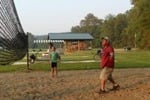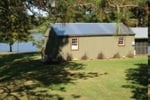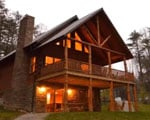TAR HOLLOW STATE PARK
Twisting park and forest roads pass through deep ravines and dense woodlands. Scattered shortleaf and pitch pines growing on the ridges were once a source of pine tar for early settlers, hence the name Tar Hollow. Dogwoods, redbuds and a variety of wildflowers color the hillsides in the springtime. Fall's pageant of color is spectacular.
At one time, Ohio was covered by a warm, shallow sea. As land rose to the east, sand and gravel were washed westward into Ohio's waters. Southeastern Ohio's sandstone was formed from this sediment. These sandstone hills are covered with a rich, diverse forest. Oak and hickory prefer the dry ridge tops of the area, while sycamore, black willow, buckeye and silver maple line the stream valleys. The forest not only supports a variety of hardwoods but also contains a vast array of ferns, mosses, mushrooms and wildflowers. Bloodroot, wild geranium, cardinal flower and Solomon's seal are typical wildflowers found in the forest.
Surrounded by the rugged foothills of the Appalachian Plateau, Tar Hollow State Park and surrounding state forest are characteristic of the wilderness that blanketed Ohio in the days of early settlers. It is a stronghold for many exciting species of wildlife. Numerous reptiles and amphibians, colorful game birds, songbirds and secretive mammals can be found here. The timber rattlesnake, dwindling in Ohio due to deforestation, holds on in Tar Hollow's forest. The five-lined skink, distinguished by its brilliant blue tail, is found in the area along with the elusive fence lizard. Painted turtles can be seen along the shores of Pine Lake while the lumbering box turtle inhabits the dry land. Salamanders such as the red-backed, dusky, long-tailed and northern two-lined thrive on the cool, moist forest floor. In spring, the wooded hollows echo with the gobbling of wild turkey and the drumming of the ruffed grouse. Rare sightings of bobcat have been reported in this unique, wild region.
This region was wilderness to early man. Indians and settlers both found the land, especially in the valleys, to be rich and fertile. Many different Indian tribes contributed to its history. From about 200 B.C. to 500 A.D., the Hopewell inhabited the area. This culture left burial mounds that can still be seen. Later both the Shawnee and Mingo claimed the area as hunting grounds.
In 1796, Nathaniel Massie platted a town on the Scioto River just north of the mouth of Paint Creek which he named Chillicothe. One hundred of the first lots were offered free to the first settlers. Farm lots in the area were sold for one or two dollars an acre, in 100- to 200-acre tracts. The area attracted many Kentuckians and Virginians. In 1803, Chillicothe became the state capital.
For a time, the ridges to the east of Chillicothe remained wilderness because the hills were too steep to farm. But as the pressure for land and lumber increased, the hills of Tar Hollow were gradually cleared and inhabited by marginal farms. Life was difficult and settlers took advantage of every resource available. The region derives its name from pine tar, an essential commodity in early Ohio households. It was taken from the knots and heartwood of the native Pitch Pine tree to be used in the home manufacture of balms, animal liniments, and lubricants for pioneer wagons and equipment.
In the 1930s, the Tar Hollow region was purchased for conservation purposes under a New Deal program, the Ross-Hocking Land Utilization Project. People were given a new financial start in life and were encouraged to move to the cities. Most, however, bought more poor ground outside the park and continued to live as they always had.
During the Depression years, recreation facilities including the 15-acre Pine Lake and group camp were built by the WPA and NYA programs. In 1939, the Ohio Division of Forestry accepted operational control of the land which was then known as Tar Hollow Forest-Park.
When the Ohio Department of Natural Resources was created in 1949, the Division of Parks and Recreation accepted land of several state agencies including the old Division of Forestry. Tar Hollow State Park was developed from the earlier forest. The park, today, is bordered by Tar Hollow State Forest -- Ohio's third largest state forest.
Ohio does not have an annual pass and does not charge entrance fees to state parks.
GeneralLand, acres604
Water, acres15
Nearby State Forest, acres16,046
Nearby Wildlife Area, acres1,361
Day-UseFishingyes
Huntingyes
Hiking Trail, miles24
Backpack Trail, miles21
Picnickingyes
Picnic Shelters, #8
Swimming Beach, feet500
Mountain Bike Trails, miles3
Bridle Trails, miles25
Nature Centeryes
BoatingBoating Limits4
CampingPrimitive, #23
Electric Sites, #71
Pets Permittedyes
Dumpstationyes
Showersyes
Group Camp, capacity100
Walk-In Campsites, #17
The campground is set in a wooded hollow near the lake. Twenty-eight electric sites and sixty non-electric sites, both sunny and shaded are available. The campground is equipped with showers, pit latrines and a dump station. Pet camping is permitted on all sites. A group camp area is available for organized groups on a reservation basis. Camping is permitted at five shelters.

Cottages and Cabins
Rustic beauty in a peaceful, clean atmosphere is the secret to this Family Retreat. The serene splendor of Mother Nature is your reward for visiting Walnut Creek. We offer cabin rentals for those who want the convenience with less effort.
11.9 miles from park*

Cottages and Cabins
Hidden Cave Cabin is an authentic log cabin with 2 bedrooms in a private wooded setting. It is located on one of the most scenic drives in Hocking Hills and just 3.6 miles to Rock House and less than 10 miles to Conkle's Hollow and Old Man's Cave.
12.6 miles from park*

Cottages and Cabins
A lakeside retreat in the beautiful Hocking Hills on scenic Lake Logan. Full kitchen, Hot Tub, Satellite HD TV, sitting room, breakfast nook, and electric AC/Heat.
18.3 miles from park*

Cottages and Cabins
Trickle Creek offers luxury cabins in Hocking Hills. The cabins are situated on nearly 236 acres of secluded cabin rentals in the deep wooded ravines in the foothills of the Appalachian Mountains in Hocking County, Ohio.
18.1 miles from park*







